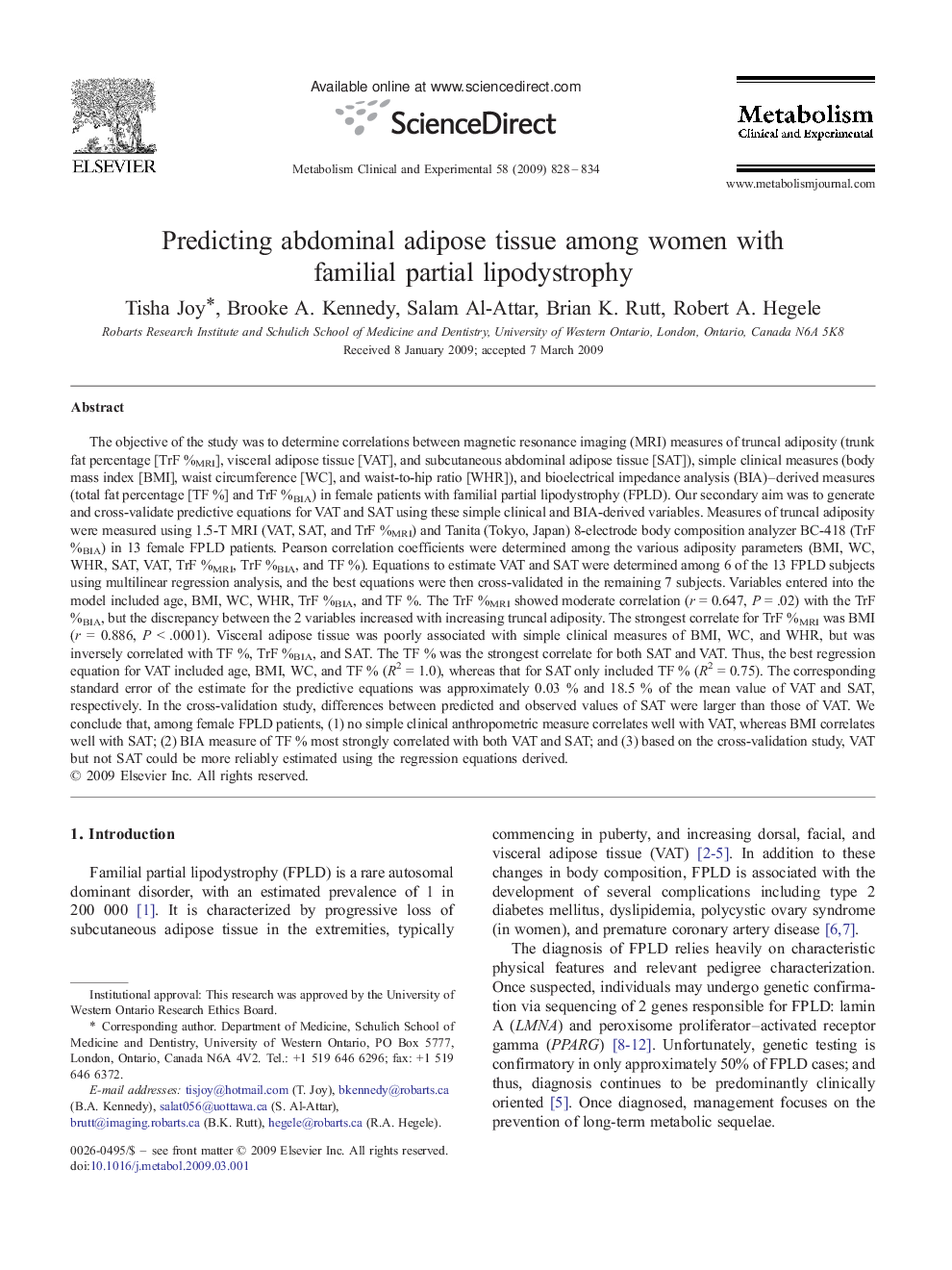| کد مقاله | کد نشریه | سال انتشار | مقاله انگلیسی | نسخه تمام متن |
|---|---|---|---|---|
| 2806893 | 1157138 | 2009 | 7 صفحه PDF | دانلود رایگان |
عنوان انگلیسی مقاله ISI
Predicting abdominal adipose tissue among women with familial partial lipodystrophy
دانلود مقاله + سفارش ترجمه
دانلود مقاله ISI انگلیسی
رایگان برای ایرانیان
موضوعات مرتبط
علوم زیستی و بیوفناوری
بیوشیمی، ژنتیک و زیست شناسی مولکولی
علوم غدد
پیش نمایش صفحه اول مقاله

چکیده انگلیسی
The objective of the study was to determine correlations between magnetic resonance imaging (MRI) measures of truncal adiposity (trunk fat percentage [TrF %MRI], visceral adipose tissue [VAT], and subcutaneous abdominal adipose tissue [SAT]), simple clinical measures (body mass index [BMI], waist circumference [WC], and waist-to-hip ratio [WHR]), and bioelectrical impedance analysis (BIA)-derived measures (total fat percentage [TF %] and TrF %BIA) in female patients with familial partial lipodystrophy (FPLD). Our secondary aim was to generate and cross-validate predictive equations for VAT and SAT using these simple clinical and BIA-derived variables. Measures of truncal adiposity were measured using 1.5-T MRI (VAT, SAT, and TrF %MRI) and Tanita (Tokyo, Japan) 8-electrode body composition analyzer BC-418 (TrF %BIA) in 13 female FPLD patients. Pearson correlation coefficients were determined among the various adiposity parameters (BMI, WC, WHR, SAT, VAT, TrF %MRI, TrF %BIA, and TF %). Equations to estimate VAT and SAT were determined among 6 of the 13 FPLD subjects using multilinear regression analysis, and the best equations were then cross-validated in the remaining 7 subjects. Variables entered into the model included age, BMI, WC, WHR, TrF %BIA, and TF %. The TrF %MRI showed moderate correlation (r = 0.647, P = .02) with the TrF %BIA, but the discrepancy between the 2 variables increased with increasing truncal adiposity. The strongest correlate for TrF %MRI was BMI (r = 0.886, P < .0001). Visceral adipose tissue was poorly associated with simple clinical measures of BMI, WC, and WHR, but was inversely correlated with TF %, TrF %BIA, and SAT. The TF % was the strongest correlate for both SAT and VAT. Thus, the best regression equation for VAT included age, BMI, WC, and TF % (R2 = 1.0), whereas that for SAT only included TF % (R2 = 0.75). The corresponding standard error of the estimate for the predictive equations was approximately 0.03 % and 18.5 % of the mean value of VAT and SAT, respectively. In the cross-validation study, differences between predicted and observed values of SAT were larger than those of VAT. We conclude that, among female FPLD patients, (1) no simple clinical anthropometric measure correlates well with VAT, whereas BMI correlates well with SAT; (2) BIA measure of TF % most strongly correlated with both VAT and SAT; and (3) based on the cross-validation study, VAT but not SAT could be more reliably estimated using the regression equations derived.
ناشر
Database: Elsevier - ScienceDirect (ساینس دایرکت)
Journal: Metabolism - Volume 58, Issue 6, June 2009, Pages 828-834
Journal: Metabolism - Volume 58, Issue 6, June 2009, Pages 828-834
نویسندگان
Tisha Joy, Brooke A. Kennedy, Salam Al-Attar, Brian K. Rutt, Robert A. Hegele,